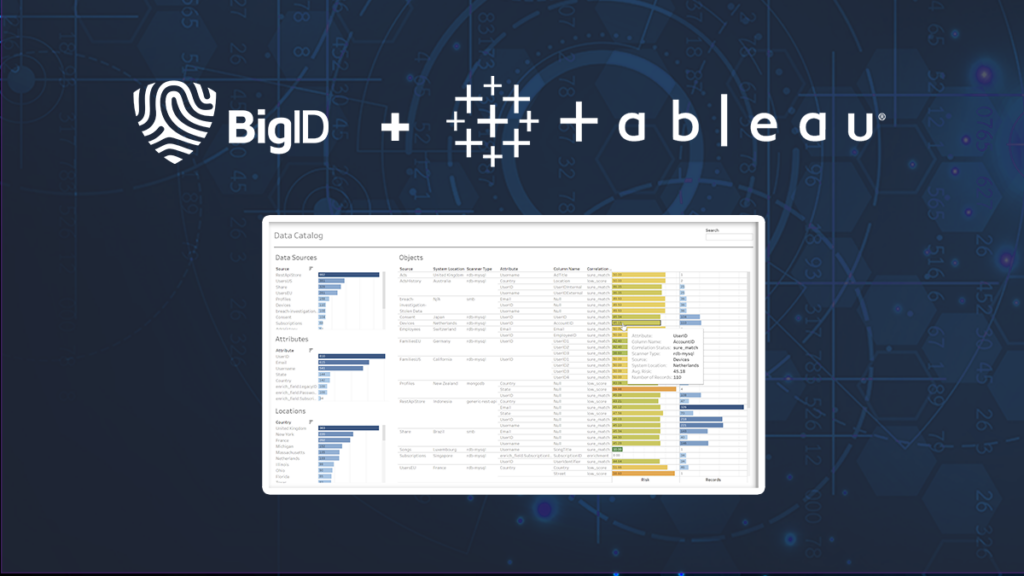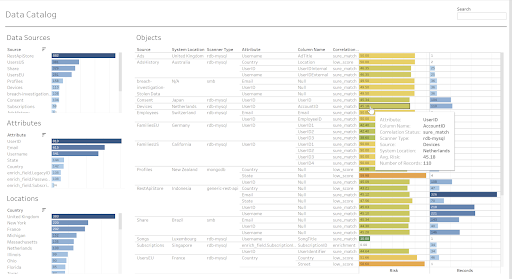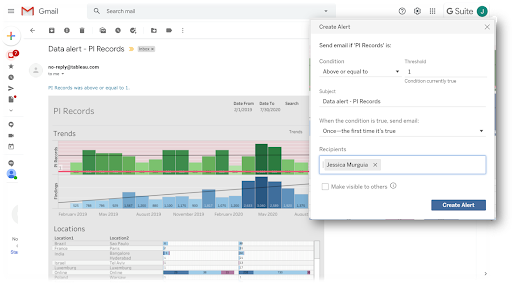How BigID and Tableau Work Together to Promote a Data-Driven Culture

Data is one of the most valuable assets in an organization – and it’s more important than ever that organizations use their data to better understand their business and make critical decisions.
That data — like all valuable things — needs to be organized, validated, protected, and audited. At the same time, organizations face new regulatory requirements for protecting and reporting on sensitive data to properly maintain, secure, and report on their users’ and customers’ data.
Business Intelligence (BI) platforms offer visual analytic tools so users can get data insights wherever and however they need by creating customized reports and dashboards. In order to get the most valuable data insights, they need to be working with the right data in the first place.
BigID’s integration with Tableau enables organizations to deliver a panoramic view of KPIs and analytics to CDOs, CIOs, CISOs, and team members looking to identify, catalog, and classify sensitive and personal data to address multiple regulatory demands.
By combining Tableau’s powerful BI capabilities with BigID’s in-depth data discovery and data intelligence, users can boost BI analytics adoption to promote a data-driven culture, improve operational visibility across the board, and reduce time-to-response to any security and privacy incidents.
With BigID and Tableau, you can:
- Find the highest quality data to drive business insights
- Visualize high value data with custom and personalized dashboards
- Act on the right data at the right time
Find the highest quality data to drive business processes
Tableau enables organizations to build storytelling analytics and leverage business reporting capabilities to easily create and navigate reports and dashboards, share insights, and collaborate with colleagues — all through an extensive library of visualizations and an intuitive drag-and-drop interface.
To guarantee trust and ultimate adoption of those analytics, the use of correct and meaningful data is critical. With broad data coverage and ML-based discovery-in-depth capabilities, BigID provides 360° data quality insights by business entities and data sources — all in a unified inventory.
By combining BigID’s discovery-in-depth and Tableau BI capabilities, IT, security and data teams can achieve full visibility across their most valuable data in a unified, accurate, and reliable way.
Custom dashboards help visualize high-value data insights
Security and IT teams need tools that help them streamline the way they visualize data across different sources due to technology-created siloes. With BigID and Tableau, teams can deliver rich visualizations and analysis of company’s high value data through dashboards that combine:
- Different lenses or views of sensitive, personal and regulated data to easily identify crown jewel data across all departments and stakeholders
- Customized KPIs to track high value data management & governance programs
- Reports to monitor all the systems and databases that contain crown jewel data or impact the core business operation
- Advanced analytics powered by BigID’s data intelligence of all the identities within the organization
At the same time, all dashboards can easily be personalized and customized to comply with organizational standards and promote quick adoption.
With Tableau, users can leverage dynamic data integration with BigID so data can be monitored and updated near to real-time. Tableau users can establish a live connection to the BigID database through the MongoDB BI connector to have automatic access to the latest data and maintain up-to-date dashboards.
 A Tableau Dashboard showing BigID Data Catalog with number of records and
A Tableau Dashboard showing BigID Data Catalog with number of records and
risk value associated per object and data source
Additionally, users have the freedom to import local BigID file-based data assets such as CSV or JSON files into Tableau. Users can easily blend the imported data with other enterprise applications and systems to create holistic views into their most important use cases.
Act on the right data at the right time
When companies have the power to discover all their crown jewel data, classify it, and correlate it to an entity or identity to meet data privacy and protection regulations, the next logical step is to respond in a timely and effective way to any data violation. This is where customized report distribution and threshold alerts play an important role.
BigID’s customizable, built-in alerting capabilities can be complemented with Tableau’s BI-based alerting mechanism. Tableau enables users to deliver personalized content (by executing the same report based on individual roles and privileges). It can notify — in near real-time — stakeholders based on threshold conditions, and deliver reports directly to a printer, file location, phone, or email to facilitate immediate actions on high value data, enabling teams to prevent potential data-related incidents and remediate violations in minutes.

Personalized emails based on customized alerts on BigID metrics through the BigID & Tableau integration
At the end of the day, organizations around the world require data they can trust to make decisions, monitor their most important data based on risk relevancy, and operationalize and accelerate their processes to manage personal, sensitive and regulated data.
The quality level at which they can accomplish these key activities directly affect the success of an organization in today’s information and privacy-driven era. Organizations leveraging the power of BigID and BI tools together to solve those scenarios will be immediately ahead of the game in their industries.
Promote a data-driven culture with BigID & Tableau
Tableau’s business intelligence and visualization capabilities combined with BigID’s deep data insight and discovery empower businesses to get more value from their data, more accurately, and at scale. Get a demo to find out more about how BigID’s data intelligence platform and Tableau can enable organizations to have a holistic view of key metrics around their sensitive and personal data, trust that data to make critical decisions, and address multiple regulatory demands.













